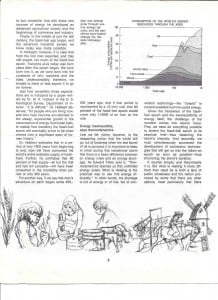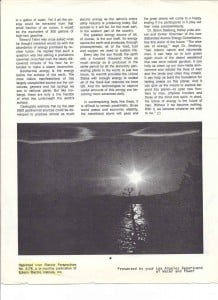Earlier I wrote about how the Ancient Greek philosophers were the first to introduce the concept of Nature, and how Nature became a new way to understand things and how they act. This new way did not replace Custom and Tradition, but it did break their monopoly on the minds of men and thus dilute its influence.
But, one does not immediately get to Science when Nature is invented in ancient Greece. Two things have to happen. First of all, it is romantic to think of each breeze as a spirit, a god the way the ancient Greeks did. As Thales who as the first philosopher and one of the seven sages said, “All things are full of gods.”
He had reasons for this statement, besides having a polytheistic viewpoint; he had observed attraction and repulsion through magnetism and static electricity. What he did not have, was Science. In order to have actual “Science,” he had to have a unified creation. In order to have a unified creation, he had to have a unified creator, big “G” God.
One idea of religion is that one can learn about creator through learning about the creation. Well, if one has millions of gods, then one has millions of different personal whims of gods, creating forces and working with or against each other, willy-nilly. Even worse than that, in a polytheistic view natural forces are the gods, there is no clear separation from nature and the gods.
On the other hand, if one has one God, then all of a sudden the world and everything in it has the potential to be orderly and constant, as long as the God is viewed as orderly and constant as well. With one big “G’ God, the Creator is “transcendent” or separate from Creation (although immanent as well, but that’s another story). Inconstancy is a weakness which should not be there in an all-powerful God. In polytheism each breeze is a spirit, but with an all-powerful God, God is not the breeze, but is “behind” the breeze. A unified viewpoint about the Divine is probably necessary for the rise of Science, historically; however, it was not sufficient.
I am not advocating any religion. I am not saying that a modern polytheist or pantheist cannot be a scientist. I am saying that the path of least resistance, the path in which Modern Science first began to develop was in the Christian world of Europe in the 15th or 16th century. Whether or not one believes in Christianity, one can recognize that it has had a historical influence.
Religion, by unifying the Natural world, paid a positive role setting the stage for Science, but in Christianity it also restricted its development through too close of a tie between Nature and Religion. Science, for its own sake, needed separation from Religion in order to come into its own. This is the second event that needed to happen before modern science came into its own. Galileo through his activities brought the issue to the forefront, but it was Rene Descartes that made the theoretical division between Nature and God, thus separating Science from the domain of Religion.
Most people know the story of Galileo. Amongst other things, Galileo discovered Jupiter’s Galilean Moons and had the audacity to suggest that like how those moons go around Jupiter; perhaps the Earth went around the Sun (heliocentric or Copernican model), instead of the other way around (geocentric or Ptolemaic model). Also, the heliocentric model was less problematic mathematically, than the geocentric model.
However, Galileo was ordered recant his position, was persecuted by the Inquisition and shown the torture rack as a threat of what would happen if did not. Galileo, however, was not exactly an innocent victim in the whole matter; he had put himself in harm’s way by moving from a safe Italian city-state (Venice) to one (Florence) where his discoveries would be an issue, religious and otherwise. When he did that, he probably thought his ideas would win people over easily and had little idea of the ordeal he would face. Galileo was trying to push the limits on knowledge, but vested interests, including the Church but also academics of the time, were in opposition.
Again, in the Middle Ages, one learned about creation (Nature) in order to know about the Creator (God). That meant that creation was in between the individual and God in a manner thus; Man -> Nature->God. When one looked at Nature, also consequently one looked toward God. That also meant that not only was the Church involved in defining man’s relationship to God, but also since one could learn about God through Nature, the Church had a strong stake in defining Nature as well. For example, another issue that created problems for Galileo was his discovery of sunspots, which demonstrated the imperfection of the Sun. What else could be imperfect if the Sun and thus the Heavens were imperfect?
Therefore, when Galileo advocated the heliocentric universe and sunspots, he was talking about Nature, but also through how Creation and the Creator were connected, he was also encroaching on the Church’s territory. Again, Galileo had some idea of what he was doing, he had moved to a city-state where it was going to be an issue. However, in order for Science to come into its own, Church doctrine about Nature had to get out of the way. Galileo brought the issue to the forefront, but another early modern natural philosopher, Rene Descartes, would complete the task.
It took Rene Descartes to realign the world and make it safe for Science. How safe the world is from Science is sometimes an interesting question. In all fairness, Descartes was claiming to make the world safe for God and the mind. Galileo’s fate was a concern to anyone who explored natural philosophy, as Science was then known. However, if Descartes made the world safe for God and the mind, then perhaps he thought the new explorations of Nature by Science would not threaten the Church whose concern was for God and the soul, the soul being somewhat the spiritual equivalent to the mind. Descartes’ approach had him in a series of meditations engaged in a radical or hyperbolic doubt, doubting the world and everything in it, until he arrived at some beliefs that could not be doubted. Those beliefs that he discovered are in one’s own mind and in God.
After doubting everything, he came to something that could not be doubted, expressed by his famous statement, “I think, therefore I am” (cogito ergo sum). He could not doubt that it was he who was doing the doubting or the thinking in all its forms. Thus, for Descartes the self is a thinking thing, and for the thinker the existence of the mind and God are certain, known through introspection. On the other hand, the World and the things in it are not so certain, they are known through that “mode of cogitation,” sensation which along with memory, brings things into the imagination.
This divides things differently from the medieval perspective of Man->Nature->God and changes it to Nature (the physical world) <-Man (the mental world) ->God. Now Man is between Nature and God, thus separating Nature from God in the domain of knowledge. We generally no longer study Nature in order to get closer to God, and if we do, we do not consider it science. This separation of God [with the spiritual mind (the soul) looking to God] on the one hand, and Nature (with scientific/technological man looking to Nature) on the other hand, is basically the split we have in the universities these days between the humanities and the hard sciences. Theology, however, is no longer queen of even the humanities.
This reorienting to the Nature<-Man->God equation is also telling in that it places Man at the center of the cosmos. Instead of existing for Nature or for God, now we increasingly exist for Man. That sounds nice… but only if we knew what that meant. In the meanwhile, Science is largely divorced from the Church, thus completing the transition from Nature. The Ancient study of Nature is a flirtation with Nature, the natural philosopher tried to tease out Nature’s secrets, and Nature often played it coy, allowing only glimpses of what was under her veil. On the other hand, Modern Science is Promethean, stealing fire from Hephaestus and the crafts from Athena. More about that some other time.





